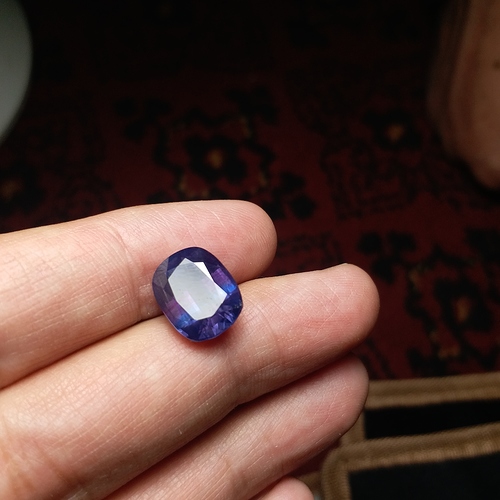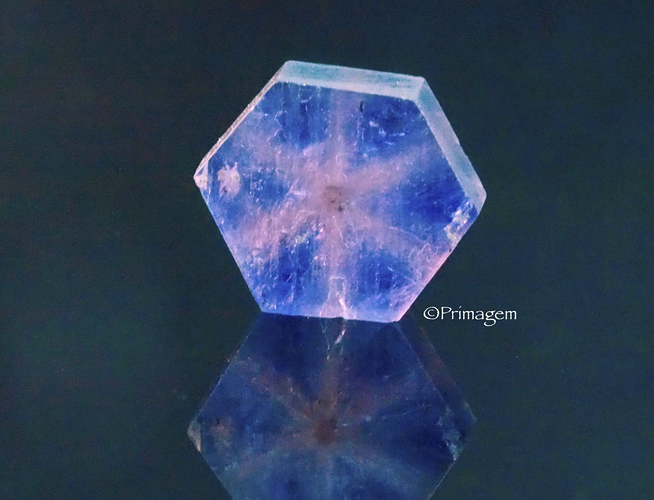Hey, Iam an collector of beauty’s. I just love gemstones, my passion.
But sometimes I get puzzled over experts opinions over some gems, and I need opinions, advice and criticism.
When it comes to corundum I think RED is the only color to be called ruby.
All pink should be pink sapphires. Now this is my personal opinion on the matter, now I need yours.
Regards Fredrik
Our Gem Society article on rubies and pink sapphires may not settle the issue, but it does point to a problem with defining rubies through color. Pink is a tint of red (red plus white). Then, how to do you choose to define “red?” Is it red as the dominant hue or is it any red regardless of tone (regardless of how light or dark the red is)?
Its never easy, and thats Why i started this topic. Cause i want opinions on the matter. Especially from people who has been a long time in the business.
The problem is people who have bought an exspensive gem is maybe just defending hot pink as an ruby. Just because.
I am in my learning process, that’s why I want to know.
Regards Fredrik
The problem is that Rubies even pink have a chemical formula that belongs to rubies, and will never become a Sapphire. Regardless of the color.
It’s all about chemistry before tone, hue etc…
Ruby and sapphire are both conundrum. The only sapphire that isn’t called sapphire is ruby and it has to be red. If someone is presenting a pink stone as ruby I would look somewhere else. When it comes to uncerted stones it is opinion as much as anything but even if they are not being dishonest a pink ruby would be a low quality color for a ruby.
I do take issue with the chemical explanation. If you think ruby, you’re at those medium dark reds & purplish reds, imho. You can’t exactly pin it down to chemistry (Thai ruby was iron-rich, in Mozambique Ruby you’ll find those with more or less iron). From point of nomenclature, every corundum that’s not classified as ruby is sapphire - put in a bit strange way: Sapphire is a residual category comprising corundum gems of different chemical compositions, and there’s different, thiugh minute, compositions of ruby as well, but all Corundum is AL2O3. So pink sapphire might be chemically vastly the same as ruby, but you simply can’t ignore that they look different. So it’s better to actually look at the stone than buying the cert. For me, anything too light in tone and saturation simply ain’t ruby but pink sapphire - beautiful gems in their own right… but just not the “real” thing when it comes to ruby.
Pink is technically desaturated red. Rubies can be pinkish red, as long as there’s a red component.
Isn’t ruby generally a much smaller stone than pink sapphire? You can find far more small rubies but you rarely find a ruby the size that some pink sapphires get to.
I wouldn’t generalize it that way. Actually, you’ll find hughe “rubies” (red corundum) if you are willing to go low quality. As gem quality “red” ruby is very rare (i.e. though, I’m uncertain how the somewhat stable output of Mocambique [Gemfields] will affect the price structure and the perceived scarcity of near flawless reds in the short to medium turn), you should logically be right. The red in ruby is due to Chromium. Higher concentrations are more rare, so pink should be more frequent.
Maybe to elaborate a bit on my recent post (was a bit in a hurry): GIA puts it that way “The red in rubies is caused by trace amounts of chromium—the redder the gem, the more chromium”. The “redder” means more saturation, given that pink is a lower saturated, light in tone red (thinking of it, it’s actually more the tone that determines pink), pink corrundum should have a lower concentration of chromium than a “red” ruby. From that should follow that compared to red (i.e. higher saturated) ruby, pinks are indeed more frequent (relatively).
But as I said - I think generalizing is a very dangerous thing. If you think about prime examples of ruby or pink sapphire (i.e. with no color mask, no flaws, no visible inclusions, appropriate saturation and size, no treatment) they’re probably both rare (perceived and acutal).
its kind of funny that all these people know so many things about Ruby,
But not a singel person seems to know that the meaning of the word Ruby = red. Not pink, not in between, ruby means red.
Until the early 20th century, the color of ruby was considered to range from the very palest pink to the deepest blood red. In fact, pink is just a low saturation of the color red. For example, if you put one drop of blood red dye in a glass and fill it with water, it will look pink. In the English language, red is the only color we assign a different name to when it is of low saturation. Light blue, light green and light yellow are all still blue, green and yellow.
It was Western gemologists who started calling light colored rubies “pink sapphires” in the early 1900’s, and the term continues to be used by many dealers and gemstone identification laboratories to this day. In India and Burma, red rubies are masculine and pink rubies are feminine, but both still considered ruby.
www.preciousgemstones.com/newsletter_pdf/gfspring17.pdf _ I thought this article on the AGL color codex would make a good topic for discussion but i found you gentleman had all ready started it . We have all seen color sets come and go . But with out a agreed on standard there is no place to even start to sort out this and other colored stone issues. I agree with Mr Bergman they all could be Rubies . _
The way they teach it at TIJT is that if it wouldn’t sell as a ruby because it isn’t “red” enough, it’s a sapphire.
Jeffrey has the history right. The fact is, pink is a desaturated red. Pink and red are a single continuum and it is difficult to say at what exact point pink ends and red begins. It is a corundum conundrum on a par with the definition of pornography. I can’t define it, but I know it when I see it.
That said, the current distinction is fairly well impeded and I would not go around calling pink corundum ruby!
RWW
In this case; it reminds me of once when I was disputing seller claims that a Siberian Amethyst was as such due to the overbearing reds showing in it. So I did a study using the color tables as to what Siberian Purple should be about and then formulated my conclusion that since Amethyst is primarily purple, the overbearing colors should be of course purple with splashes of Red mixed in; but not so overpowering that one would question whether it was even an Amethyst any longer.
Such was the case at the time as I saw many sellers commanding higher pricing for such stones on places like Ebay and otherwise. I think the same goes for Rubies. Being a gem dealer, I have seen seen sellers pawning off primarily purple rubies from Thailand when anyone who has any sense of legitimacy would tout them as Sapphires of course.
But then it comes to the age old saying, It depends on if you are the buyer or the seller. and as funny as that may sound to some, it definitely has a lot of truth to it. As for Rubies, I would think the most overbearing play of color in the Corundum should of course be red, playing along with the color tables as to what real red is.
Then again, heating the stones, which is more common than not these days, who’s to say there was not tinges of purple or overbearing pinks in it to begin with. Who’s to say what that stone really looked like once it came out of the ground. As with Pigeon Blood Rubies, which is a just a phrase coined in Burma a long while ago, it literally meant getting the stones to as close as to the natural reds as possible.
So there again, we have the color tables as play. In doing so, many will set the stones in yellow gold as yellow offsets purple in the color tables, so of course most high value rubies you might see coming out of Burma and other places, are usually set in yellow.
Does this mean the stones are not reddish pink, pinkish red, or even slight purple. Who’s to say, unless you take the stone out and examine it and taking a chance of damaging it, well you get the idea.
We could probably do a whole case study on this point, particularly when it comes to classifying whether or not the color tables should have any play into how to classify rubies. Which I think they should.
All over the world, you’ll see sellers, in particular, selling Rubies that personally most ethical parties should be classifying as Sapphires. And as such it comes down again to the same thing, it really does depend on if you’re the buyer or the seller.
Can we, or should we argue that shades of red, such as pinkish red, or reddish pink, whatever phrase you want to use, are not actual pure reds That may be so, if our previously noted term, pigeon blood applies. Then again, I’ve seen this term abused and used, just as with the term I first noted; Siberian Amethyst. But that’s okay with me, I prefer to say away from this flea infested area.
I may have 10s of thousands of carats of rubies, but preferentially for the reasons, I’ve noted, I really do prefer to say away from this area that you practically need a GIA report to distinguish what’s real anymore or what’s not. And even them, who’s to say.
It’s much like not long ago, reports coming out of newer lab diamonds that would pass most Gemologist tests. And 90% or more of Jeweler’s would think they were actually real diamonds. Then we get into the argument, well lab diamonds being made with the same materials are real and so on and so forth.
As for the coveted once Big 4, Diamond, Ruby, Emerald and Sapphires, I stay away from all but Emerald these days as I have not seen a test yet that can duplicate what you see from a Colombia Emerald. This is not to say I don’t have many pounds or 1000s of carats from other regions, but preferentially of course I know quality when I see it.
The U.S. standard of red for ruby is above 80%, but I believe around 87%. The Burmese ruby color is the epitome of what all colors of red should aspire to. So, pink, purple, and reds with orange and purple are not rubies. Remember, red is one of the 3 primary colors. Any other color added to it is not red.
Makaturquoise
GIA AJP

